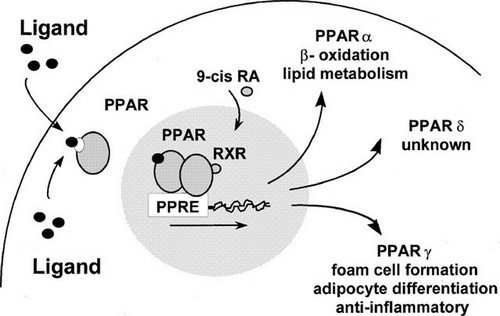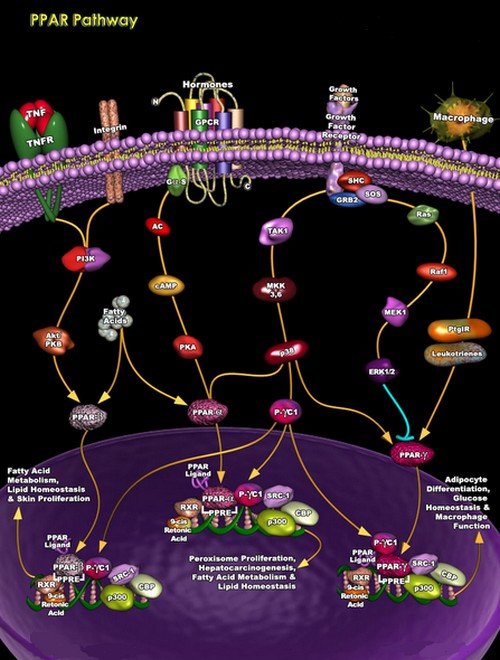PPAR
What is a PPAR?
It stands for peroxisome proliferator activated receptors, which are activated by ligand transcription factors of nuclear hormone receptor superfamily.
PPAR play a vital role in metabolic functioning of the body as well as in energy homeostasis. PPAR belongs to the family of phylogenetically related protein known as nuclear hormone factor.
Their structure is similar to that of the thyroid hormone receptor and they are stimulated in response to small lipophilic ligands. Peroxisome proliferator activated receptors have the domain structure similar to that of the other members of the nuclear receptor family. (1, 2)

Photo 1: A diagram presentation showing how peroxisome proliferator activated receptors function in the body.
Picture Source: www.researchgate.net
 Image 2: A biochemical presentation of peroxisome proliferator activated receptors.
Image 2: A biochemical presentation of peroxisome proliferator activated receptors.
Photo Source: www.biolegend.com
Peroxisome proliferator activated receptors isoforms
PPAR Gamma
What is PPAR gamma and its function? The PPAR gamma function was linked to regulating the development of adipocyte. As time passes by and more research has been made, the complex function of PPAR gamma was established. Today, PPAR gamma is potentially helpful in treating a huge array of health conditions such as inflammation, diabetes mellitus type 2, dyslipidemia, and malignancy, to name a few. (2)
PPAR Alpha
PPAR alpha is a type of protein that has the ability to speed up the breakdown of fat in the liver and other parts of the body. The PPAR alpha function is focused on the metabolism of the body so as to increase the production of energy. It also has the ability to alter the expression of a huge number of genes.
How is PPAR alpha activated? Calorie restriction can trigger the action of PPAR alpha. It is useful in ketogenesis, which is a body’s way of adapting to prolonged fasting. Where can you find PPAR alpha? You can found PPAR alpha in the liver, heart, kidney, and brown fat. A small amount of PPAR alpha can be found in the muscles, adrenal glands, and small and large intestines. (2, 3)
PPAR alpha activation helps in the uptake, utilization, and breakdown of fatty acids. How? It works by increasing the number of genes that act in the transport, binging, activation, and oxidation of fatty acids. It also increases the production of glucose and secretion of bile.
If you are in a fasting stage, the PPAR alpha helps the body cope in the absence of food. Without it, your will be suffering from major metabolic disturbances such as fatty liver disease and hypoglycaemia. (4)
PPAR alpha plays a major role in drugs and toxins detoxification. It also has the ability to inhibit autoimmune disease like multiple sclerosis. It protects the body from possible heart disease by inhibiting the inflammation of macrophage and boosting cholesterol efflux. It is beneficial to people who want to build their muscles because PPAR alpha can significantly increase IGF-1. It facilitates fat loss by increasing UCP-3 (R).
If you want to increase the amount of PPAR alpha in your body, then you have to increase your intake of polyunsaturated fatty acid, omega-6, arachidonic acid, and linoleic acid metabolites. (5, 6)
PPAR Delta/Beta
PPAR Delta or Beta is a nuclear receptor encoded by the PPARD gene. It encodes a member of PPAR family. PPAR delta/beta plays an important role in the production of energy, alleviating pain and inflammation, improving the functions of the heart, improving the body’s endurance, and reducing obesity.
In fact, this nuclear hormone receptor is important in promoting hair growth and preventing heart disease. A high level of PPAR delta increases the energy expenditure of the body. It also increases the fat burning ability of the muscles and fat cells.
On the other hand, a low level of PPAR delta increases the formation of fat cells. There is a study conducted that revealed a high level of PPAR delta in patients with colorectal cancer. (5, 6, 7, 10)
Other notable functions of PPAR delta/beta include the following:
- It decreases the expression of cannabinoid receptor.
- It decreases inflammatory cytokines like macrophage and TNF related inflammation.
- It prevents TNF induced apoptosis in skin cells.
- It plays an important role in the activation of PPAR gamma and PPAR alpha.
- PPAR delta aids in weight loss, fights autoimmunity, and inhibits Th1 and TH17 immune system. (8, 9)
What is a PPAR agonist?
PPAR agonists are classification of drugs that directly acts on the PPAR. They are beneficial in treating metabolic syndrome as they help in lowering the level of blood sugar and triglycerides. There are various types of PPAR agonist.
The PPAR gamma is the primary target of TZDs (thiazolidinediones), which is used in insulin resistance diabetes mellitus. They are also useful in the treatment of hyperlipidemia in patients with atherosclerosis. On the other hand, PPAR delta is the primary target of a chemical GW501516. PPAR delta agonist modifies the body’s preference of fuel, switching from glucose to lipids. (9)
PPAR Supplements
PPAR supplements are created to target the PPAR level in the body. They are a perfect alternative to the pharmaceutical medications. They are safe and effective. One of the highly preferred PPAR supplements is Sesamin. It is a lignan naturally present in the seeds and oil of sesame.
What is a lignan? It is a molecule that binds with a receptor or other entity that acts as activator. It is a highly powerful PPAR alpha agonist. It offers a highly promising result in obese patients as well as patients suffering from diabetes mellitus type 2.
PPAR supplement containing Sesamin can greatly increase the oxidation of fat in the mitochondria. It also increases the oxidation of peroxisomes by increasing the release of enzymes primarily involved in fatty acids beta oxidation. It improves the expression of carnitine palmitoyl transferase (CPT), a mitochondrial enzyme. (5, 8, 9)
References:
- https://en.wikipedia.org
- www.ncbi.nlm.nih.gov
- www.medscape.com
- www.bodybuilding.com
- www.nature.com
- https://selfhacked.com
- www.scbt.com
- immunology.sciencemag.org
- www.sciencedirect.com
- Regulation of lipid metabolism and adipogenesis by the PPAR and LXR families of nuclear receptors, Sarah Rebecca Hummasti, University of California, Los Angeles, University of California, Los Angeles, 2006
Published by Dr. Raj MD under Medical Physiology.
Article was last reviewed on August 6th, 2018.

